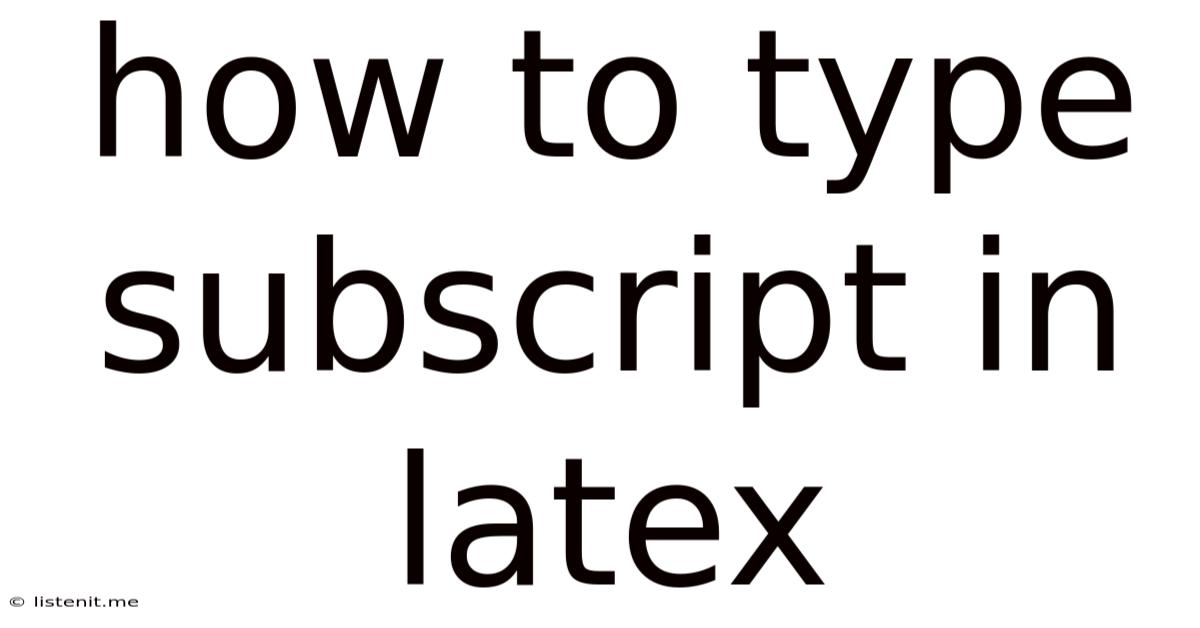How To Type Subscript In Latex
listenit
Jun 15, 2025 · 5 min read

Table of Contents
How to Type Subscript in LaTeX: A Comprehensive Guide
LaTeX, a powerful typesetting system, offers a robust and elegant way to handle mathematical notation, including subscripts. Understanding how to properly typeset subscripts is crucial for creating professional-looking documents, particularly in scientific, mathematical, and technical fields. This comprehensive guide will delve into various methods for creating subscripts in LaTeX, catering to different levels of complexity and specific use cases. We'll explore the basics, delve into advanced techniques, and address common issues, ensuring you become proficient in this fundamental aspect of LaTeX.
The Basic Method: Using the Underscore Character
The simplest and most common way to create a subscript in LaTeX is using the underscore character (_). This method is perfect for single-character subscripts or simple expressions.
Example:
$x_i$ % produces xᵢ
$a_1$ % produces a₁
$y_k^2$ % produces yₖ² (subscript and superscript)
This method is intuitive and readily understood. Simply place the underscore character immediately before the character or expression you want to use as a subscript. Note that you need to enclose the entire expression within dollar signs ($...$) for inline math mode or double dollar signs ($...$ or \[...\]) for display math mode.
Limitations:
The underscore method is limited when dealing with multi-character subscripts or complex expressions. For instance, $x_ij$ will render as xᵢj, incorrectly treating ij as a single subscript. This is where more advanced techniques come into play.
Using Braces for Multi-Character Subscripts
For subscripts involving multiple characters or expressions, curly braces ({}) are essential to group the subscript elements correctly. This ensures LaTeX interprets the entire content within the braces as a single subscript.
Example:
$x_{ij}$ % produces xᵢⱼ
$a_{123}$ % produces a₁₂₃
$y_{k+1}$ % produces yₖ₊₁
The braces clearly define the boundary of the subscript, preventing ambiguity and ensuring correct rendering. This is crucial when dealing with subscripts containing mathematical operators, variables, or numbers.
Handling Spaces within Subscripts:
If you need to include spaces within a subscript, use the \text{} command from the amsmath package. This allows you to include text within the subscript while preserving the correct spacing.
\usepackage{amsmath}
...
$x_{\text{max}}$ % produces xₘₐₓ
$y_{\text{i+j}}$ % produces yᵢ₊ⱼ
Remember to include \usepackage{amsmath} in your document's preamble to use the \text{} command. The amsmath package provides enhanced mathematical typesetting capabilities.
Advanced Subscript Techniques: Nested Subscripts and More
LaTeX’s flexibility extends to creating nested subscripts and handling more complex scenarios.
Nested Subscripts:
You can create subscripts of subscripts by simply applying the underscore method recursively.
$x_{i_j}$ % produces xᵢⱼ
$a_{b_{c}}$ % produces aᵇᶜ
However, for improved readability, particularly with deeply nested subscripts, consider using a different approach or adjusting the font size to prevent overly small characters.
Subscripts with Fractions:
Handling subscripts with fractions requires careful use of braces and potentially the \frac{}{} command for proper rendering.
$x_{\frac{i}{j}}$ % produces xᵢ⁄ⱼ
$a_{i+ \frac{1}{2}}$ % produces aᵢ₊₁⁄₂
The braces ensure that the fraction is correctly treated as a single subscript unit.
Subscripts with Integrals and Other Operators:
When incorporating subscripts with integrals or other mathematical operators, the same principles apply: use braces to enclose the entire subscript expression.
$\int_{a}^{b} f(x) dx$ % produces ∫ₐᵇ f(x) dx
$\sum_{i=1}^{n} x_i$ % produces Σᵢ₌₁ⁿ xᵢ
The amsmath package simplifies such operations, offering a more structured and readable method for handling integrals and summations.
Troubleshooting Common Subscript Problems
Despite the straightforward nature of subscript creation, some common issues can arise.
Incorrect Spacing:
Incorrect spacing usually stems from missing braces. Always use braces around multi-character or complex subscripts to avoid unexpected spacing.
Overlapping Subscripts and Superscripts:
When dealing with both subscripts and superscripts, especially with large characters, overlapping can occur. Adjust spacing manually using \! (negative thin space) or \; (thin space) for fine-tuning.
$x_{i}^{j}$ % Might overlap, try: $x_i^j$ or $x_{i}^{\!j}$ for better spacing
Font Size Issues:
In nested subscripts, the font size might become too small. You can adjust the font size using commands like \scriptstyle or \scriptscriptstyle. However, excessively small fonts can reduce readability.
Improving Readability: Best Practices for Subscripts
While correctly implementing subscripts is crucial, focusing on readability enhances the overall document's quality.
Consistent Usage:
Maintain consistent subscript usage throughout your document. Use braces consistently to avoid ambiguous interpretations.
Contextual Clarity:
Ensure the context clearly defines the meaning of your subscripts. Poorly defined subscripts can make the document difficult to understand.
Avoid Overuse:
While subscripts are essential, avoid excessive use. In some instances, alternative notations might improve readability and clarity.
Conclusion: Mastering LaTeX Subscripts for Professional Documents
Mastering subscript creation in LaTeX is a fundamental skill for any user aiming to create professional-looking documents, particularly in scientific, mathematical, and technical writing. By understanding the basic techniques and employing advanced strategies when needed, you can ensure your documents are not only mathematically correct but also visually appealing and easily comprehensible. Remember that consistent use of braces, careful consideration of spacing, and a focus on readability are key elements in producing high-quality LaTeX output. With practice and attention to detail, you'll confidently create complex equations and formulas containing subscripts with precision and elegance. This guide provides a thorough foundation, empowering you to tackle increasingly complex subscript scenarios in your LaTeX projects. Remember to consult the comprehensive LaTeX documentation for further details and advanced techniques as your expertise grows.
Latest Posts
Latest Posts
-
Internal Energy Of An Ideal Gas
Jun 16, 2025
-
Root System Of A Maple Tree
Jun 16, 2025
-
Replaced Smoke Detector Battery Still Beeping
Jun 16, 2025
-
Smoke Alarm Still Chirping After Battery Change
Jun 16, 2025
-
Copper Clad Aluminum Wire Vs Copper
Jun 16, 2025
Related Post
Thank you for visiting our website which covers about How To Type Subscript In Latex . We hope the information provided has been useful to you. Feel free to contact us if you have any questions or need further assistance. See you next time and don't miss to bookmark.